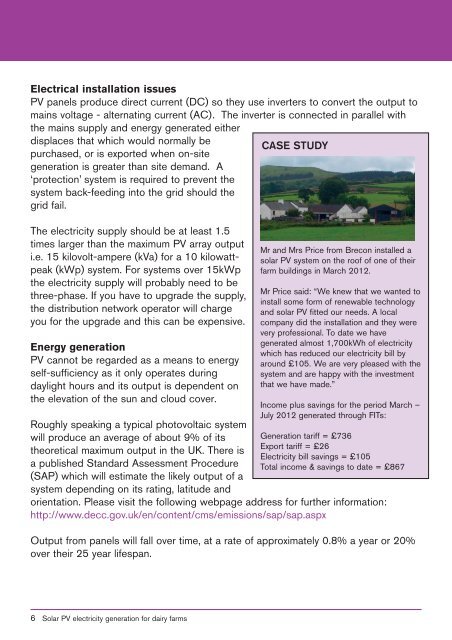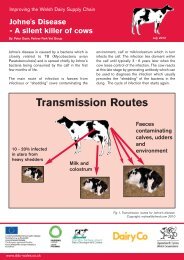Solar Photovoltaic Electricity Generation for Dairy Farms
Solar Photovoltaic Electricity Generation for Dairy Farms
Solar Photovoltaic Electricity Generation for Dairy Farms
You also want an ePaper? Increase the reach of your titles
YUMPU automatically turns print PDFs into web optimized ePapers that Google loves.
Gelli Aur <strong>Solar</strong> PV A5_13605 Practical sheep breeding 16/07/2012 09:02 Page 6<br />
Electrical installation issues<br />
PV panels produce direct current (DC) so they use inverters to convert the output to<br />
mains voltage - alternating current (AC). The inverter is connected in parallel with<br />
the mains supply and energy generated either<br />
displaces that which would normally be<br />
CASE STUDY<br />
purchased, or is exported when on-site<br />
generation is greater than site demand. A<br />
‘protection’ system is required to prevent the<br />
system back-feeding into the grid should the<br />
grid fail.<br />
The electricity supply should be at least 1.5<br />
times larger than the maximum PV array output<br />
i.e. 15 kilovolt-ampere (kVa) <strong>for</strong> a 10 kilowattpeak<br />
(kWp) system. For systems over 15kWp<br />
the electricity supply will probably need to be<br />
three-phase. If you have to upgrade the supply,<br />
the distribution network operator will charge<br />
you <strong>for</strong> the upgrade and this can be expensive.<br />
Energy generation<br />
PV cannot be regarded as a means to energy<br />
self-sufficiency as it only operates during<br />
daylight hours and its output is dependent on<br />
the elevation of the sun and cloud cover.<br />
Roughly speaking a typical photovoltaic system<br />
will produce an average of about 9% of its<br />
theoretical maximum output in the UK. There is<br />
a published Standard Assessment Procedure<br />
(SAP) which will estimate the likely output of a<br />
system depending on its rating, latitude and<br />
Mr and Mrs Price from Brecon installed a<br />
solar PV system on the roof of one of their<br />
farm buildings in March 2012.<br />
Mr Price said: “We knew that we wanted to<br />
install some <strong>for</strong>m of renewable technology<br />
and solar PV fitted our needs. A local<br />
company did the installation and they were<br />
very professional. To date we have<br />
generated almost 1,700kWh of electricity<br />
which has reduced our electricity bill by<br />
around £105. We are very pleased with the<br />
system and are happy with the investment<br />
that we have made.”<br />
Income plus savings <strong>for</strong> the period March –<br />
July 2012 generated through FITs:<br />
<strong>Generation</strong> tariff = £736<br />
Export tariff = £26<br />
<strong>Electricity</strong> bill savings = £105<br />
Total income & savings to date = £867<br />
orientation. Please visit the following webpage address <strong>for</strong> further in<strong>for</strong>mation:<br />
http://www.decc.gov.uk/en/content/cms/emissions/sap/sap.aspx<br />
Output from panels will fall over time, at a rate of approximately 0.8% a year or 20%<br />
over their 25 year lifespan.<br />
6 <strong>Solar</strong> PV electricity generation <strong>for</strong> dairy farms











